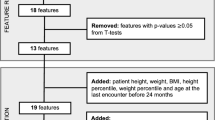Abstract
The epidemiological question of concern here is “can young children at risk of obesity be identified from their early growth records?” Pilot work using logistic regression to predict overweight and obese children demonstrated relatively limited success. Hence we investigate the incorporation of non-linear interactions to help improve accuracy of prediction; by comparing the result of logistic regression with those of six mature data mining techniques.
The contributions of this paper are as follows: a) a comparison of logistic regression with six data mining techniques: specifically, for the prediction of overweight and obese children at 3 years using data recorded at birth, 6 weeks, 8 months and 2 years respectively; b) improved accuracy of prediction: prediction at 8 months accuracy is improved very slightly, in this case by using neural networks, whereas for prediction at 2 years obtained accuracy is improved by over 10%, in this case by using Bayesian methods. It has also been shown that incorporation of non-linear interactions could be important in epidemiological prediction, and that data mining techniques are becoming sufficiently well established to offer the medical research community a valid alternative to logistic regression.




Similar content being viewed by others
References
Abu-Hanna, A., & de Keizer, N. (2003). Integrating classification trees with local logistic regression in intensive care prognosis. Artificial Intelligence in Medicine, 29, 5–23.
Agrawal, R., & Srikant, R. (1994). Fast algorithms for mining association rules. In Proc. 20th Int’l. Conf. Very Large Data Bases (VLDB’94), (pp. 487–499).
BBC, Editor (2005). TV watching link to child obesity, Retrieved February 27, 2008, from BBCNews website: news.bbc.co.uk/2/hi/health/4562879.stm.
Bhargava, S. K., Sachdev, H. S., Fall, C., Osmond, C., Lakshmy, R., & Barker, D. J. P. (2004). Relation of serial changes in childhood body-mass index to impaired glucose tolerance in young adulthood. New England Journal of Medicine, 350(9), 865–875.
Bouchard, C., Tremblay, A., Despres, J. P., Nadeau, A., Lupien, P. J., & Theriault, G. (1990). The response to long-term overfeeding in identical twins. New England Journal of Medicine, 322(21), 1477–1482.
Buchan, I. (2005). Child obesity look harder approach via whole-population. School of Medicine, University of Manchester.
Buchan, I. E., Bundred, P. E., Kitchiner, D. J., & Cole, T. J. (2007). Body mass index has risen more steeply in tall than in short three year olds: serial cross-sectional surveys 1988–2003. International Journal of Obesity, 31, 23–29.
Cole, T. J., Freeman, J. V., & Preece, M. A. (1998). British 1990 growth reference centiles for weight, height, body mass index and head circumference fitted by maximum penalized likelihood. Statistics in Medicine, 17, 407–429.
Fayyad, U. M., & Irani, K. B. (1993). Multi-interval discretization of continuous-valued attributes for classification learning. In Proc. 13th Int’l Joint Conf. on Uncertainty in AI, (pp. 1022–1027). Morgan Kaufmann.
Gortmaker, S. L., Dietz Jr., W. H., Sobol, A. M., & Wehler, C. A. (1987). Increasing pediatric obesity in the United States. American Journal of Diseases of Children, 141(5), 535–540.
Han, J. & Kamber, M. (2006). Data mining: Concepts and techniques (2nd ed.). Morgan Kaufmann.
John, G., & Langley, P. (1995). Estimating continuous distributions in Bayesian classifiers. In Proc. 11th Conf. Uncertainty in Artificial Intelligence (pp. 338–345). Morgan Kaufmann.
Kononenko, I. (1993). Inductive and Bayesian learning in medical diagnosis. Applied Artificial Intelligence, 7, 317–337.
Liu, H., & Yu, L. (2005). Towards integrating feature selection algorithm for classification and clustering. IEEE Transactions on Knowledge and Data Engineering, 17(4), 491–502.
Osei-Bryson, K.-M., & Giles, K. (2006). Splitting methods for decision tree induction: an exploration of the relative performance of two entropy-based families. Information Systems Frontiers, 8(3), 195–209.
Quinlan, J. R. (1993). C4.5: Programs for machine learning. Morgan Kaufmann.
Remco, R. B. (2005). Naive Bayes classifiers that perform well with continuous variables. In Proc. of the 17th Australian Conf. on AI (AI 04), LNCS, 3339, 1089–1094.
Rokach, L., & Maimon, O. (2005). Top-down induction of decision trees classifiers—a survey. IEEE Transactions on Systems, Man and Cybernetics, Part C, 35(4), 476–487.
Ross, J. G., & Pate, R. R. (1987). The national children and youth fitness study II: a summary of findings. Journal of Physical Education, Recreation and Dance, 58(9), 51–56.
Tjortjis, C., Saraee, M., Theodoulidis, B., & Keane, J. A. (2007). Using T3, an improved decision tree classifier, for mining stroke related medical data. Methods of Information in Medicine, 46(5), 523–529.
Vapnik, V. (1995). The nature of statistical learning theory. Springer-Verlag.
Vapnik, V. (1998). Statistical learning theory. Wiley.
Witten, I. H., & Frank, E. (2005). Data mining: Practical machine learning tools and techniques. 2nd Ed. Morgan Kaufmann.
Wolf, M. C., Cohen, K. R., & Rosenfeld, J. G. (1985). School-based interventions for obesity: current approaches and future prospects. Psychology in the Schools, 22(2), 187–200.
Author information
Authors and Affiliations
Corresponding author
Rights and permissions
About this article
Cite this article
Zhang, S., Tjortjis, C., Zeng, X. et al. Comparing data mining methods with logistic regression in childhood obesity prediction. Inf Syst Front 11, 449–460 (2009). https://doi.org/10.1007/s10796-009-9157-0
Published:
Issue Date:
DOI: https://doi.org/10.1007/s10796-009-9157-0



